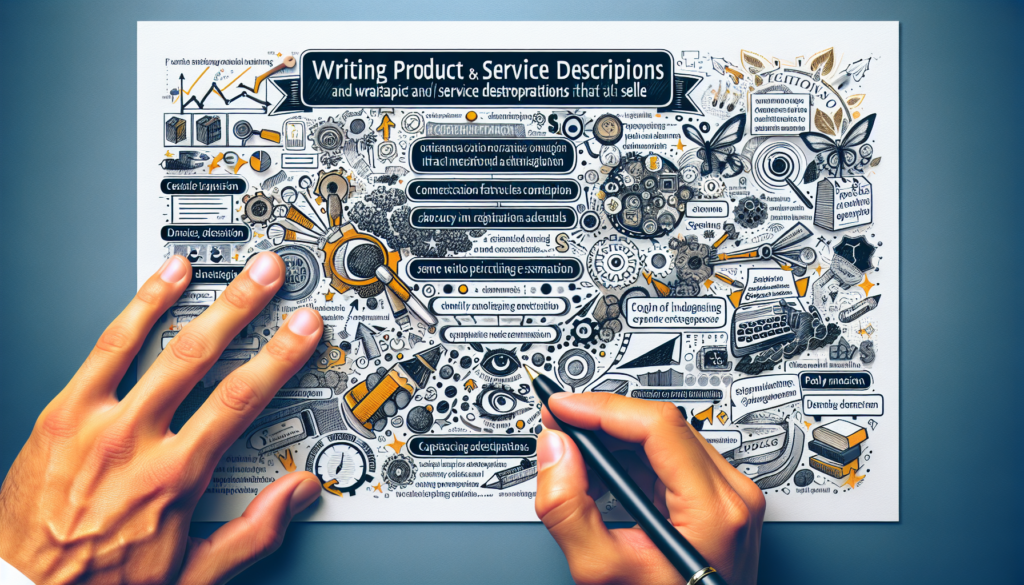In the digital age, writing product and service descriptions transcends simple feature listing, demanding a blend of persuasive language with accurate technical details. This approach must resonate with consumer needs and interests, while establishing clear differentiators in a saturated, competitive market. Let’s explore the sophisticated techniques and methods redefining marketing and e-commerce writing, along with their practical uses and measurable outcomes.
Advanced Writing Techniques in Product Descriptions
Effective writing employs a range of techniques and methods, born from extensive studies and market testing. These form the foundation of what’s deemed best practice for descriptions that not only inform but also sell.
Consumer Psychology and Persuasion
Deep understanding of the target audience: Knowing your consumer goes beyond demographics; it’s delving into their psychology and behaviors. The creation of buyer personas is pivotal to tailor language and selling points to the emotional and logical triggers of the buying decision.
Cialdini’s Principles of Persuasion: Their deployment in product descriptions is crucial. They comprise scarcity (real or perceived), authority (spotlighting the brand’s credibility and expertise), commitment and consistency (drawing the customer into the brand narrative), liking (forming emotional bonds), reciprocity (providing value before soliciting a purchase), and social proof (displaying feedback and reviews from other customers).
SEO Copywriting
SEO-focused copywriting is crucial. Descriptions need to weave in strategic keywords that align with user searches, boosting search engine visibility and ranking. But, these should be melded seamlessly to maintain a fluid and captivating read.
Storytelling and Narrative Components
Incorporating story elements into descriptions animates the product and cultivates an emotional link. This can encompass the product’s backstory, the brand ethos, or even anecdotes showing its use in everyday life.
Structure and Readability
Information design is also key. Enhanced readability with succinct paragraphs, distinct subheadings, bullet lists, and emphasizing core points in bold text aids in retaining content and betters the user experience.
Practical Applications and Case Studies
Next, we review real cases where the writing strategy for descriptions has proven efficacious.
Case Study: E-commerce Description Optimization
A notable instance is the redrafting of descriptions for a prestigious electronics brand that, after employing advanced writing techniques and SEO, noticed a marked rise in click-throughs and advanced its SERP (Search Engine Results Pages) placement.
Keyword Research and Implementation: Detailed keyword exploration facilitated the use of high-search, low-competition words in those descriptions.
Refining Titles and Meta Descriptions: Titles and meta descriptions were revamped to attract user attention in search outputs.
Addition of Multimedia Elements: Top-tier images and videos complemented the text descriptions, lifting page engagement and duration.
Outcomes: The results included a 30% uptick in conversions and a notable improvement in user interaction.
Innovations and Future Perspectives
Artificial Intelligence in Description Writing
AI is revolutionizing description crafting. Tools like GPT-3 and bespoke machine learning solutions allow for the creation of exceptionally pertinent and individualized text at an unparalleled speed and magnitude.
Predictive Analytics and Customization
Predictive analytics and heightened customization are advancing towards descriptions that are not just optimized for the masses but tailored individually, based on behavioral data and buying preferences.
Augmented Reality and Interactive Descriptions
Integrating augmented reality will deliver a more immersive experience, letting users visualize and personalize products in a 3D space, radically transforming descriptions and the manner we interact with them.
Conclusion
In conclusion, selling product and service descriptions must be a convergence of sophisticated writing techniques, insights into human behavior, and smart technology use. As the marketplace progresses and digital tools evolve, product descriptions are morphing into holistic experiences, crafted not just to inform but to engage the consumer’s imagination and influence their purchasing path.

